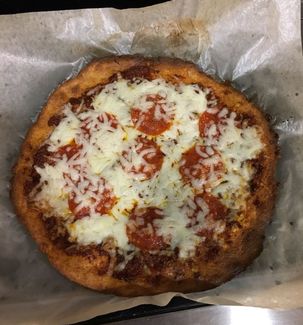|
Since so many friends and family ask me similar questions when they start out investing in cryptocurrency, I decided to write a very basic guide to help guide people on how to safely, easily, and cheaply buy cryptocurrency like Bitcoin, Ethereum, and Litecoin. Check out the guide below or feel free to download it!
0 Comments
The Start. I started the Ketogenic Diet two weeks ago with my dad, after he read about it in "Tools of Titans" by Timothy Ferriss. Granted, my goal was definitely not to lose weight, but I like a challenge and some claim they feel better while in Ketosis so I thought why not? My dad and I made a deal to stick with it for two weeks. I decided that for my diet, I would be incredibly strict with my carb intake and minimize the amount of net carbs (total number of carbs minus dietary fiber) as much as possible. I wanted to enter Ketosis as quickly as possible to get the full benefits and the best way I knew how to do that was quit carbs almost completely. To start, I took one day to prep myself (body and mind) by limiting the amount of carbs I ate without being super strict, you know to make sure I really wanted to do this. It was a little tough, but doable so onward I went. The next day, my diet begun. Shopping. I went to the grocery store without a clue of really what to buy, thinking I'd figure it out on the spot. I know there are a ton of recipes and routines online for Keto, but I decided to wing it. I looked around the store, scanning the nutritional label on everything that caught my eye to find nearly everything had carbs. I eventually just stood there on my phone asking Google "Is this ok for Keto?", "Is that ok for Keto?. After about 1.5 hours, I finally checked out. Little did I know that I'd be returning to the grocery store every day for the next three days restocking on the things I ate and looking for new foods I could eat. Keto Flu. The first few days I felt okay, even pretty good at some points. At other points I felt like I was starving myselft, but it wasn't as awful as it sounds. After about three days, I started feeling sick. Really sick. I would get really bad headaches. I couldn't concentrate on anything. I felt like I was dying. I did some research into it and found many referred to it as the "Keto Flu", which happens when the body adjusts to burning ketones instead of glucose. Initially while in Ketosis, the body gets rid of excess insulin through fluids, which results in rapid weight loss, but also rapid loss of electrolytes. The loss of electrolytes is usually the culprit of these symptoms and I realized I needed to add more sodium, magnesium, and potassium to my diet. I was feeling like the grim reaper was ready to take me away any minute, so instead of figuring out which foods would help me at that point I immediately drove to GNC and bought an overpriced bottle of Magnesium and Potassium Aspartame. I took it immediately and felt so much better.
I also got really tired of making and planning all of my meals and avoiding eating out. I started going out to eat and ordered foods that I knew had limited or no carbs, like chicken or sashimi salads. Sometimes it got tricky as many low carb foods that you can order have sauces that add a ton of carbs that you wouldn't expect. A big life saver was "The Melt", a chain that serves grilled cheese, burgers, etc. All of their nutritional information is on their website and you have the option to build your own, so I quickly became a regular customer ordering double burgers on a lettuce bun. It tasted great, filled me up, and was zero-carbs! I also discovered some foods you can buy and make quickly and easily. "BUBBA Burger", oh so good! Throw on some cheese and get some guacamole or avocado spread with some lettuce and you have yourself a very delicious burger, with no carbs with almost no work. Another little snack I really enjoyed were Chicken & Maple Breakfast Sausages by Applegate. I also discovered an amazing salad dressing called "Tessemae's All Natural Dressing & Marinade" Balsamic flavor. I ended up buying while on a ski trip to Lake Tahoe with some friends. It has no carbs, no preservatives, or additives. Ketogenic Diet or not, this I think this is now one of my favorite dressings, it was so good that we finished in one night! Exercise. I'll admit I didn't explicitly exercise as much as I would've liked. I went to the gym a few times, but didn't stick to a strict routine or anything. Most of my focus was spent on the diet and being strict, leaving little motivation to work out. I did ski while on the diet, however. I expected to be a lot weaker and have a lot less endurance, but overall I didn't really notice a difference. In fact I felt pretty good! Even when we stopped for lunch I would opt for a hot dog without the bun and some veggies, but didn't feel nearly as hungry as everyone else. I didn't even feel a need to stop for food or the rest. Overall, I would say I felt like I was at average to above average performance. Whether thats true or not, it's hard to say since I didn't have any metrics to go by. Ketosis? What's That?
Our body needs energy to function. So where do we get it? We first get that energy from carbohydrates (carbs), which are then converted to glucose. But what if we stop eating carbs? Do we die? The answer is no. Our bodies are incredibly resilient and if our bodies no longer have carbs to turn to for energy, our bodies turn to fat for energy. Even the brain, which burns the most energy of any other organ at about 20%, can easily use fat instead of carbs to keep us functioning. Once you limit your carb intake for long enough your insulin levels drop, your body starts converting fat into Ketones in the liver, and you enter a metabolic state known as Ketosis. The Ketogenic Diet. This brings us to the Ketogenic Diet. Originally this diet was developed in 1924 by Russel Wilder who found that it was an effective treatment for epilepsy. Since then the diet has gained some traction for weight-loss. In general a Ketogenic diet is one that is high in fat, low in carbs, with a reasonable amount of protein. Generally, you want your intake to be about 70% fat, 25% protein, and 5% carbs for a standard Ketogenic Diet. There are a lot of different ways to approach this kind of diet, some gradually reduce their carb intake over time to make it easier to start the diet, while others quit cold turkey. Regardless, the most important factor in a Ketogenic Diet is a restriction in carbohydrate intake and replacing that deficit with fat. It is important to not replace that deficit with protein as excess protein can be converted to glucose, inhibiting Ketosis. Why? So, why would anyone do such a thing? Yep, you guessed it weight-loss. Ketosis is a great way to lose weight and burn off that unwanted fat. BUT, it also has other benefits as well. There is evidence that supports that Ketogenic diets provide symptomatic and disease-modifying activity in a broad range of disorders ranging from Alzheimer’s and Parkinson’s disease to traumatic brain injury and stroke. (Gasior, Maciej, Michael A. Rogawski, and Adam L. Hartman. “Neuroprotective and Disease-Modifying Effects of the Ketogenic Diet.” Behavioural pharmacology 17.5-6 (2006): 431–439. Print.) |
AboutA personal blog about my interests, thoughts, experiences, work, life, and everything else. ArchivesCategories |
||||||||||||








 RSS Feed
RSS Feed